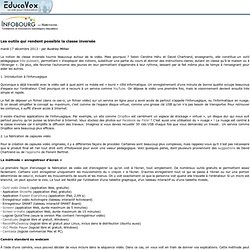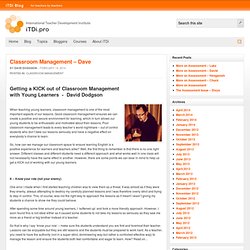

Les outils qui rendent possible la classe inversée. La notion de classe inversée tourne beaucoup autour de la vidéo.

Mais pourquoi ? Selon Caroline Hétu et David Chartrand, enseignants, elle constitue un outil pédagogique très puissant, permettant « d’expliquer des notions, substituer une partie du cours et donner des instructions claires, autant en classe qu’à la maison ou à l’étranger ». De plus, elle favorise l’autonomie des jeunes en leur permettant d’apprendre à leur rythme, laissant par le fait même plus de temps à l’enseignant pour aider les autres. 1.
Introduction à l’infonuagique Quiconque a déjà travaillé avec la vidéo sait à quel point ce média est « lourd » côté informatique. Le fait de déposer un fichier (dans ce cas-ci, un fichier vidéo) sur un service en ligne pour y avoir accès de partout s’appelle l’infonuagique, ou l’informatique en nuage. Il existe d’autres applications de l’infonuagique. 2. Pour la création de capsules vidéo originales, il y a différentes façons de procéder. La méthode « enregistreur d’écran » 3. Use of Tablets in Flipped Classroom Education M. Do’s and Don’ts for Flipping Your C. Adobe & Flipped Classrooms - The Changing F. Teaching with Technology: Components of a Flipp. Teaching that's tailored to learners. Flipped Teaching Experience. Tools for flipping your class #flipped #flip #t.
Flipped Teaching Experience. The Four Pillars of Flipped Learning ~ Educatio. Schools are doing Education 1.0; talking about doing Education 2.0; when they should be planning Education 3.0. Schools are doing Education 1.0; talking about doing Education 2.0; when they should be planning and implementing Education 3.0.

This post seeks to compare the developments of the Internet-Web to those of education. The Internet has become an integral thread of the tapestries of most societies throughout the globe. The web influences people’s way of thinking, doing and being; and people influence the development and content of the web. The Internet of today has become a huge picture window and portal into human perceptions, thinking, and behavior. Logically, then, it would seem that schools would follow suit in mimicking what is happening via the Internet to assist children and youth to function, learn, work, and play in a healthy, interactive, and pro-social manner in their societies-at-large. Education 1.0 Most schools are still living within and functioning through an Education 1.0 model. Derek W. Education 1.0 is, like the first generation of the Web, a largely one-way process. Blended learning revolution: Tech meets traditi. Creating interactivities in e-Learning: 10 ways to challenge and engage your Learner.
Lets be honest – Learning is not always an activity we look forward to.

Trainings can be monotonous, especially in the context of ‘pure’ technology-aided learning. You do not have an instructor talking to the class, cluing in when attention flounders and suitably interjecting relief from time to time. More on Assessment – David. Helping Young Learners Get the Most Out of Assessment – David Dodgson One of the biggest ‘changes’ I have witnessed in my current school during the ten years and more I have worked here concerns assessment.

When I started here, pencil and paper testing was king, dictating students’ grades and condensing their learning efforts of the previous few weeks into a concise 45 minute grammar-based test (as is the case in the majority of schools in Turkey). However, there have been ‘changes’ (the reason for using inverted commas around ‘changes’ will be become clear as you read on): first, we were introduced to the CEFR; following that, portfolios and self-assessment were introduced to our in-house assessment programme; an increased emphasis was placed on project work; rubrics were created for grading classroom performance; and the Cambridge YLE tests (Starters, Movers, and Flyers) were brought in for the appropriate year groups.
So, I guess the exam is here to stay. Test the whole language.
"Hot slips", a non-invasive correction technique. Whenever our students are working in pairs or groups, we always notice their mistakes.

Then we are faced with the dilemma: Should I correct now or not? The advice is to delay the correction, it is best not to interrupt because we shouldn´t cut a student´s stream of language. And it makes sense. Imagine yourself interrupting with a correction every time the student has made a mistake, it may be too often and may become boring, annoying, and demotivating.Procedure: Some years ago, I read an article that suggested a simple technique called “Hot slips”. 1. 2. 3. Teaching Tips 4: Classroom Management. 10+ Classroom Management Techniques. For those who prefer to see and listen rather than read check out the video above, but be sure to turn up your volume.

Be sure to read the end of the blog though as there are 3 additional tips! Making a difficult young learner group better. Making a difficult young learner group better Submitted by admin on 14 January, 2009 - 19:10 Why are some young learner classes successful and others a constant struggle?

We have all seen teachers who can walk into the classroom and their pupils immediately pay attention and fall silent. However, I would say that this is not the case for the majority of young learner teachers who have to work hard to keep students interested and engaged in lessons. I would like to explore in this article some possible strategies which could be used when a teacher is faced with a challenging group of young learners. My experience of working with YL groups is mainly in the setting of after-school English lessons in Barcelona, Spain.
What Students Remember Most About Teachers. Greenwich educators flip for new teaching metho. Classroom Management – Dave. Getting a KICK out of Classroom Management with Young Learners - David Dodgson When teaching young learners, classroom management is one of the most important aspects of our lessons.

Good classroom management ensures we can create a positive and secure environment for learning, which in turn allows our young students to be enthusiastic and motivated about their lessons. Poor classroom management leads to every teacher’s worst nightmare – out of control students who don’t take our lessons seriously and have a negative effect on everybody’s chance to learn. So, how can we manage our classroom space to ensure learning English is a positive experience for learners and teachers alike?
Well, the first thing to remember is that there is no one right answer. Making Connections - Classroom Management with Young Learners (Webi... Flipped Teaching Experience. Mr. Stowell's Flipped English Classroom. Why Feedback Needs To Be Integrated Into Flippe. EzPeasy - A video based "teaching engine&q. EzPeasy. Flipped Teaching E. Flipped Teaching Experience. CrazyForEducation Flip Teaching. Are You Ready to Flip? Getting the most out of project based learning. Creating interactivities in e-Learning: 10 ways.
Mediacore: Revision of Elasticities. Teaching Children to Be Responsible For years, parenting experts have advised us to use reward and punishment to discipline our children.

That seemed to make sense. It was logical. If we want our children to exhibit a certain behavior, reward them. Give them a treat. Give them a clear incentive to follow direction, get good grades, respect their elders, etc. Reward doesn't work because, simply put, it teaches our children that they are entitled to payment for their cooperation. So, if we remove reward and punishment, what do we put in its place? Giving children choices helps them to build self-esteem, develop independence and encourage cooperation. Examples for young children: This is the last book we'll be reading tonight. Giving children freedom to choose eliminates power struggles. We all make choices in our lives and experience consequences as a result of those choices. Robin Kevles-Necowitz, is a licensed professional counselor and parenting coach in Fairless Hills, Pennsylvania.
In-Class Flip Vs Flipped Classroom Learning. British Council English Language MOOC To Be Lau. Flipped Teaching Experience. FOX News Viewers FLIP OUT Over Class Teaching A.